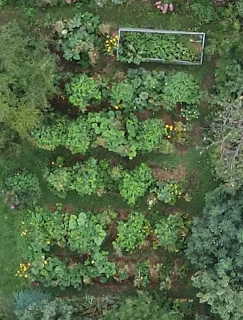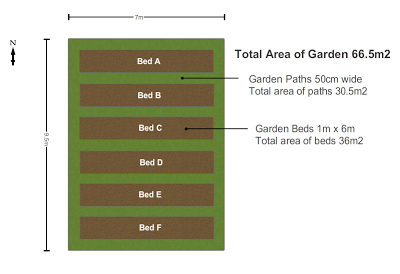Over an 8 month period we grew a polyculture on 66.5m2 of land which was cultivated 100% biologically. From it we harvested 94.68 kg of tomatoes, 6.81 kg of basil, 36.77 kg of beans 10.61 kg of courgette and 12.33 kg of winter squash. How much time do you think it took to grow this quantity?
The results are in! It's satisfying to have completed the first year study of our annual vegetable and herb polyculture/guild. The results are pleasantly surprising and we're now feeling very encouraged to expand the garden next year.
See here for the results of our polyculture studies from 2014 - 2016
You can read an introduction to the garden in a previous post here.
Garden Overview
Climate: Continental Temperate
Latitude: 42°
Elevation: 580m
Average Annual Rainfall: 588.5mm
Co-ordinates:42°42′N 25°23′E
Annual Vegetable and Herb Garden - 66.5m2
Photo taken mid September 2014 by Smilyan Pavlov from Huma
Garden Layout
Garden area: 66.5m2
Cultivated beds area: 36m2
Paths: 30.5m2
click here to see table: http://balkanecologyproject.blogspot.bg/2014/11/productive-polycultures.html
Annual Vegetable and Herb Garden.
Path and Bed Layout
Crop List
66 x Tomato - Solanum lycopersicum
66 x Basil - Ocimum basilcium
36 x Runner Beans - Phaseolus coccineus
36 x French Beans - Phaseolus vulgaris
18 x African Marigold - Tagetes erecta
18 x French Marigold - Tagetes patula
2 x Courgette - Cucurbita pepo
8 x Winter Squash - Cucurbita pepo
The table below shows the floral species composition of each bed including the different cultivars and the dates that the plants were sown or planted. Beans, courgettes and winter squash were sown. Tomatoes, basil and marigolds were planted.
Other crops such as chilli peppers, parsley, salad chicory and New Zealand spinach were also grown in small quantities throughout the beds to fill in spaces. The yield of these plants, being so small, are not considered in these records. Also not included are the native wild plants that are encouraged to grow around the perimeter of each bed. Many of these plants provide a harvest of salad greens and tea ingredients as well as mulch material within the beds.
click here to see table: http://balkanecologyproject.blogspot.bg/2014/11/productive-polycultures.html
Planting Scheme
Below is a typical representation of the planting scheme within a bed.
Soil Analysis
Soil samples were taken in early winter and sent to Dr Trendafilov from the Agricultural University Plovdiv.
click here to see table: http://balkanecologyproject.blogspot.bg/2014/11/productive-polycultures.html
Sample №
pH
N
( mg/100g)
P
( Р2О5)
( mg/100g)
K
K2O
( mg/100g)
Ca
(mg/kg)
Mg
(mg/kg)
№ A
Vegetable Beds-Shipka
7,19
3,74
195,9
137,24
12438
8478
Results
Input:Time Spent in Garden
The total time spent on the garden was 24 hours and 50 minutes, based on one person carrying out all the tasks listed below. The garden tasks were split into seven main categories. We have the specific activities of each task recorded and would be happy to share our spreadsheets. Send us an email or leave your details below if you would like this information.
Set up/Pack up - 420 minutes
Planting and Sowing - 241 minutes
Weeding - 249 minutes
Tomato care - 420 minutes
Mowing paths - 89 minutes
Summer/ Autumn Mulching - 41 minutes Irrigation - 30 minutes
Input: Fertility
67.2L - Planting out compost (applied as top dressing to each plant when planted out) 400ml per plant
32.8L - Seedling medium (applied in "nests" made in the straw to facilitate better germination of the seeds) 400ml per nest
120L - Compost - 20L per bed
30L - Ash - 5L per bed
9 Straw Bales - 1.5 bales per bed
33kg Comfrey (fresh cut weight) - 5.5kg per bed
Output: The Harvest
The total produce from each of the main crops in the polyculture were as follows.
Tomato - Solanum lycopersicum : 94.68kg
Basil - Ocimum basilcium : 6.81kg
Fresh Runner Beans - Phaseolus coccineus and French Beans - Phaseolus vulgaris : 34.47kg
Dried Runner Beans - Phaseolus coccineus and French Beans - Phaseolus vulgaris : 2.3kg
Courgette - Cucurbita pepo : 10.61kg
Winter Squash - Cucurbita pepo :12.33kg
The crops were weighed directly after harvest. Only produce of marketable quality was recorded.
click here to see table: http://balkanecologyproject.blogspot.bg/2014/11/productive-polycultures.html
Table showing recorded Input and Outputs throughout the season April 2014 - November 2014
Considerations
Records do not include the gathering of materials, compost, tools, plants etc, and assumes that everything is on site ready to go. Harvesting was not recorded although we do intend to record this next season.
We grow our own plants from seed, make our own composts and sowing mediums, grow our own summer and autumn mulch, save seeds from tomatoes, basil, marigolds and beans. The support materials (stakes and bean poles) needed for the garden are harvested from a nearby alder coppice. Therefore we have not included this cost in our records.
This year we experienced above average quantities of rainfall regularly dispersed throughout the growing season. This lead to reduced time spent on irrigation.We irrigated during the "dry season" (mid July - mid September ) once as opposed to a normal year where we would irrigate approximately once a week during this same period.
The moist conditions resulting from high rainfall created below optimal conditions for tomato growth and provided ideal conditions for tomato disease to proliferate. Many local tomato growers lost their entire crops without a harvest. Furthermore, early season temperatures were far from ideal resulting in slow fruiting of the tomato crop. Records from previous years show first tomato's harvest around Mid June as opposed to this year 22nd July. The above mentioned disease also resulted in the early demise of the plants with the last harvest of poor quality fruits (not included in the total) recorded on the 26th September in contrast to mid October in previous years.
The garden usually includes chickens in mobile pens however we did not use the chicken tractors within the garden this year. The reason for this was due to the uncertainty of obtaining a valid measurement of the fertility inputs of the chickens. Furthermore, we wanted to make the design as easy to replicate as possible.
We have lots of beneficial habitat and high biodiversity designed into the surrounding garden area that serves to attract pest predators and pollinators, repels pests and provides fertility to the garden as a whole. It would be very interesting to set up a control study on another site nearby without the high levels of biodiversity and designed habitat to see how the harvests compare.
Improvements for Future Studies
Biodiversity Study
We would like to add a measurement of biodiversity to the records and chart how this changes from year to year. Specifically, we would like to look at soil microbiology and invertebrate diversity.
We could begin a measure of soil microbiology by sending samples to a lab. This will be quite expensive and we do not have the finances available for this at the moment.
For the invertebrate study we could practice similar methods as the "Plants for Bugs" experiment carried out by the expert team at RHS Wisley, wherein invertebrate samples are taken on five occasions throughout the year. The samples are gathered using pitfall and baited refuge traps for ground fauna, and direct observation of flying insect visitors and those settled on the plants. We are currently seeking collaboration with entomologists that could assist us with this part of the study.
Recording Harvest Time
Next season we will record the time it takes to harvest the produce. We estimate this to be around the same amount of time it takes to establish, plant and maintain the garden, i.e 25 hrs. The time it takes to harvest in such a system will be longer than within a monoculture due to the increased distance between plants and the natural way that they are allowed to grow. For example, the beans tend to tangle making it time consuming to locate the pods without damaging shoot growth.
Soil Samples
Soil samples were taken in early winter after the ash was added to the beds. This was a mistake and this year we have our samples before ash and other fertlisers have been applied.
Sharing, Feedback and Collaboration
We have our record keeping spreadsheets on Google Docs. These spreadsheets include the details of work undergone in each labour "Input" category, the dates and weights of each harvest, and materials and tools used . We would be happy to share these - just drop us an email or leave a comment below with your contact details. We would also be happy to hear your suggestions and feedback on how you think we could improve the record keeping for the future and hear about similar results from other guild/polycultures you may have heard about or established yourself. Lastly, if you feel you have something to contribute to our study, we would be happy to receive your assistance.


Hi! I am a robot. I just upvoted you! I found similar content that readers might be interested in:
https://www.permaculture.co.uk/articles/how-much-food-can-you-grow-polyculture
Ill resteem this later when its fallen down the list.
I think theres not enough people yet to appreciate the quality and originality of your workThis is great work again @balkep.
Thank you